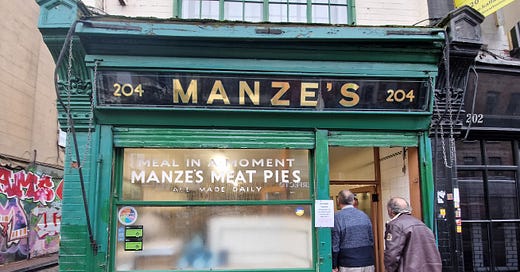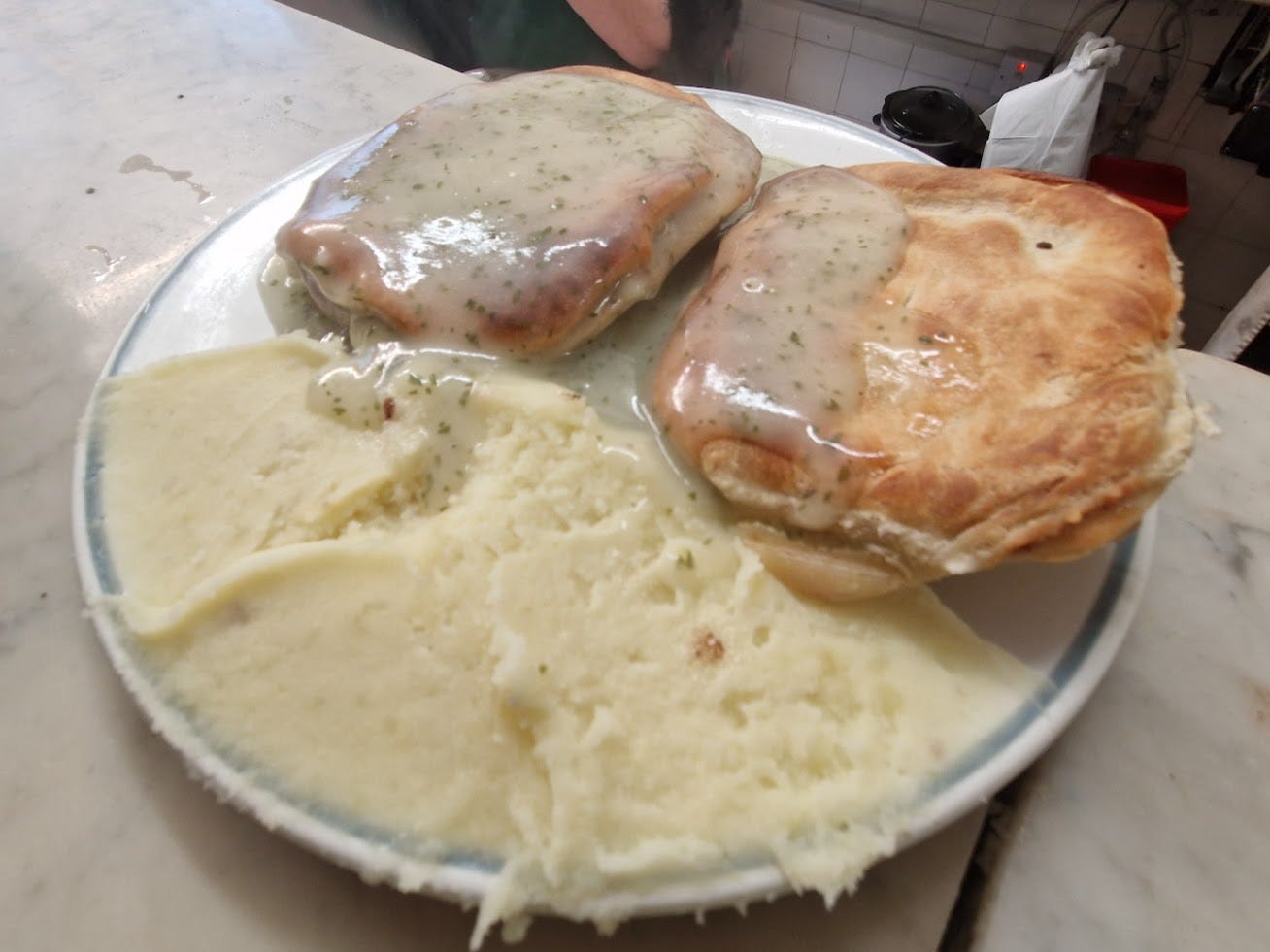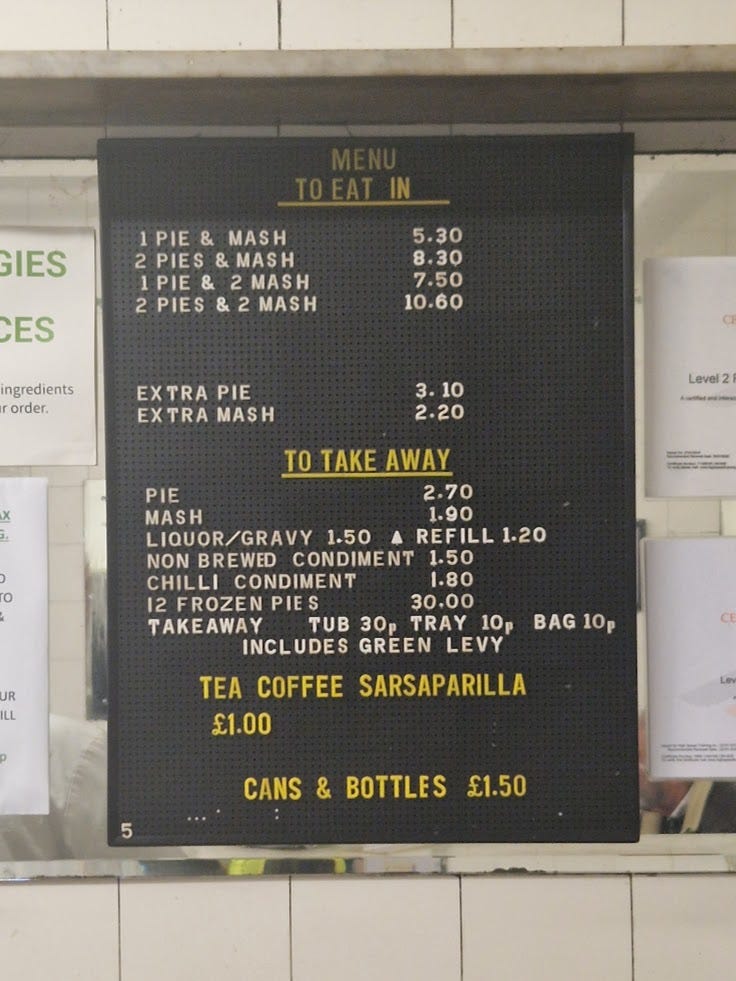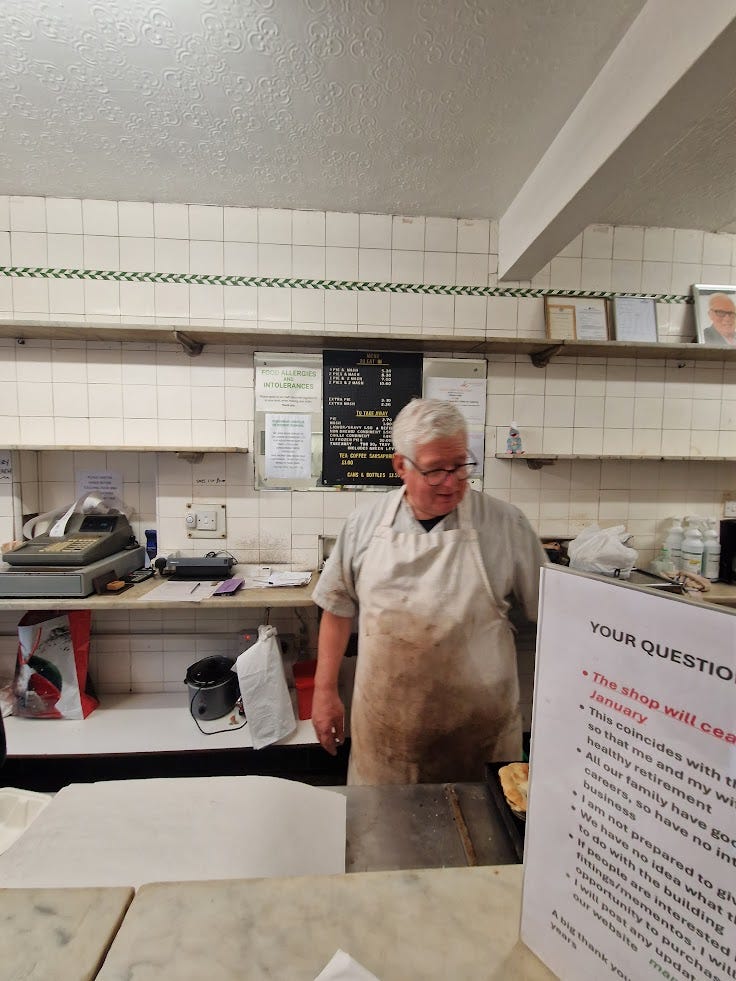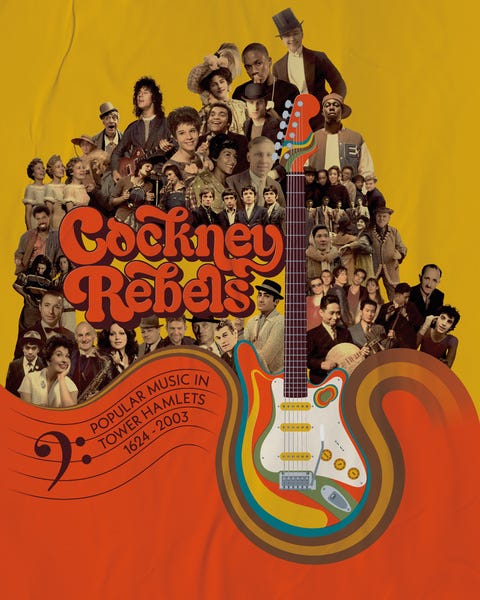MY LONDON LIFE: LAST RITES FOR A PIE & MASH SHOP, OLIVER! RETURNS TO THE WEST END & COCKNEY REBELS (redux)
Homage to Lionel Bart, Georgia Brown, pies and a traditional working class London that is rapidly changing.
ADIOS MANZE’S PIE & MASH SHOP, DEPTFORD
This morning I cycled down the Old Kent Road, through New Cross to Deptford. I live in Peckham (SE15) and Deptford (SE8) is just over two miles further southeast. I normally don’t cycle anywhere in the morning – being a night owl, I rise late and slowly slurp cups of tea until I’m awake enough to approach the world – but I wanted to visit at Manze’s on Deptford High Street. And every time I’ve attempted to do so in recent months I’ve arrived too late: Manze’s, if you’re not a Londoner, was a chain of pie and mash shops founded by Italian migrant Michele Manze at the dawn of the 20th Century.
Manze’s served what was then the favourite food of working class Londoners: a mince meat pie with mashed potato + jellied eels (not on the same plate). In the 1930s the Manze family ran thirteen pie and mash shops across London. Since then, as more different cuisines have become available across London, the popularity of pie and mash has declined and the Manze’s in Deptford is closing for good on January 25. This leaves only a Manze’s in Peckham and one in Tower Bridge, alongside a handful of other pie and mash outlets in working class white London’s nooks and crannies (and a few in Essex and Kent – where many of the Cockneys have migrated to).
I mentioned “arriving late” – 1pm is “late” when it comes to the Deptford branch. The owner, George Mascall, has been running his business on what could be considered part-time hours for several years: open Wed – Sat 9.30 am – 12.30 am (albeit sometimes staying open as late as 2pm on Saturday due to football – Millwall FC’s den is 1.5 miles away). Anyway, George is intent on retiring and, as none of his three children want to enter the trade (and there have been no outside offers), he is closing the business for good. George is a descendent of Michele Manze and the closing of his outlet signals how London continues to change.
I arrived before midday and noted a queue stretching outside Manze’s door. I joined it and, observing the clientele, felt like I had entered a lost episode of Only Fools & Horses: the shop was packed with blokes, young and old, predominantly white and working class. They exchanged good natured banter amongst themselves and with the woman at the til, very droll, very Cockney. Everyone not only looked similar but ate the same dish: pie and mash with liquor (a green sauce made from parsley): this branch of Manze’s stopped serving jellied eels a long time ago (they’ve declined in popularity yet Brian’s seafood stall on East Street - that I covered a while back - still sells them) . And, unlike some of the surviving pie and mash shops, Deptford’s doesn’t offer a veggie pie or a fruit pie (with custard) for desert. You can have a minced beef pie and mash (with or without liquor) and your choice is down to how many pies/servings of mash you want on your plate.
Spoilt for choice? This is the grub that built London.
As we queued George brought forth hot trays of freshly baked pies. The woman at the til asked him how many more trays were forthcoming, emphasising that she was working later than her allotted time. “One more,” replied George. Obviously, the attention the closing of the Deptford branch is attracting means he’s busier than he’s been in years. Thus the queue as old customers return and those who have never set foot here before ensure they do so before this emblem of Victoriana vanishes for good.
All pie and mash shops look similar – white tiles walls and marble floors and table tops. The pies are baked out back and the heat and smell of fresh pastry illuminated the shop. Beyond an electronic card reader nothing here has changed for decades: the cash til must be nearing fifty and there’s no radio, TV, art on the walls or anything else to distract from the serious business of eating. Actually, the only thing here stopping me believing I’d slipped through time to the mid-20th Century was the absence of a fug of cigarette smoke.
George Mascall unloading pies. The sign “Your Questions” details why his shop is closing and, no, he will not give you his pie recipe!
I ordered a takeaway pie – it was too early for lunch considering I’d only had breakfast around 10am – and cut back past the queue (still stretching out the door) across Deptford High Street to Upside Down Records. Upside Down is a record shop, mostly used, and before it opened (just over a year ago) it used to be Goddard’s Pie & Mash shop. When Upside Down first opened they still had Goddard’s lettering on the large window and when I posted a photo of such on social media I got some excited comments from viewers whose idea of heaven was a record shop that sold pie and mash. Sorry, not this time. After a bit of digging and listening I glanced through the window and the shutters were already pulled down over Manze’s. It was 1pm. George is obviously intent on not staying open longer so to cater to demand.
I had a good dig in Upside Down and found 4 old R&B 45s and a copy of Mad Dogs & English Men, the Joe Cocker double live album from 1970. Having recently read an epic biography of Leon Russell, the Okie pianist who masterminded Cocker’s epic backing band (and used the tour to launch his own successful solo career), I decided I’d have a listen to what was the cutting edge sound of rock’n’roll 55 years ago. I’m listening now – having eaten my pie – and just as that era has long been over, so too is the era of pie and mash shops drawing to a close. I could mourn their passing as a sign that London is losing its Cockney cuisine (and culture) but, being a Kiwi, I can only note that our pies in Aotearoa are so vastly superior to those of our former colonial master I’m surprised the likes of Manze’s lasted so long.
Once a pie & mash shop, now a used record shop: Upside Down sits almost opposite Manze’s.
COCKNEY REBELS (redux) at BRICK LANE BOOKSHOP
In early October I cycled with my pal Ian to the Tower Hamlets Local History Library & Archives. This turned out to be a grand 19th Century building just off the main Whitechapel High Road and not far from Mile End Station. We had made the journey across the river (or, in our case, under the river – there are foot tunnels in Greenwich and Woolwich that enable pedestrians and cyclists to cross the Thames without setting foot on a boat). Our reason for crossing from south east to north east London was not to sample the local pie and mash but to visit the Cockney Rebels: Popular Music in Tower Hamlets, 1624-2003 exhibition. Yes, almost 500 years of local music making celebrated in a free exhibition.
Here’s my report of our visit: https://garthcartwright.substack.com/p/cockney-rebels-popular-music-in-tower
Cockney Rebels remains open until February 21st and anyone interested in either a) vernacular music over the centuries or b) London’s urban development, should visit. Last night I attended the launch of the Cockney Rebels’ catalogue launch at the Brick Lane Bookshop (a wonderful emporium that stocks more books on the East End than your average library and recently won Best Independent Bookshop UK). The event was hosted by Alan Dein, a noted broadcaster on Radio 4/BBC London and historian of the Jewish East End, and featured the exhibition’s curator (Rob) and archivist (Andrew). Launching a catalogue when there’s little over a month left of an exhibition that has run since last summer might appear capricious but whose in a hurry when you’re dealing with half a millennium of music making?
More prosaically, I imagine that time and funding were tight and the colourful catalogue will long be treasured by anyone with an interest in East End music making. Anyway, it meant most everyone in the audience had visited Cockney Rebels and there was an amazing amount of local history knowledge being shared – Alan started by asking the audience questions Rob had set and every one of them was answered correctly (showing my rock roots I answered both of the following: which famous heavy metal band whose first ever concert was in a Stepney pub in 1978 and which punk band played one of their first gigs at the Stepney College Student Union in late 1975 – yes, Iron Maiden and the Sex Pistols).
Some of the audience members had amazing anecdotes: the guy who ran Whitechapel’s celebrated Paul For Music record shop recalled a young Dizzy Rascal bringing in his white label 12 inch 45s, which the shop sold on sale-or-return. When Dizzy won the Mercury Prize in 2003 he returned and spent £500 in the shop!
It was an enjoyable evening, even if some of those in attendance were beyond obsessive – one woman was enraged that the panel hadn’t discussed the Irish community’s contribution to East End music making and hurled directives at them (and us) as if she was holding the floor at a revolutionary workers meeting decades before (as she surely had).
Whitechapel has changed so much since I arrived in London – in the 90s it was almost entirely Bangladeshi, alongside Blooms, the noted kosher restaurant, and the two beigel shops (both still trading 24/7) while struggling artists rented huge studios for a pittance in what once had been factories and warehouses. Now, well, its a chic, upmarket area to hang in.
Denise Jones, the owner of Brick Lane Bookshop, opened the evening describing how she had run book shops in Whitechapel for close to fifty years – its remarkable that she’s managed to survive as her bookshop truly honours the community (and Alan Dein hosts an East London-themed book event here every month: check the shop’s website for more info’).
Copies of the Cockney Rebels catalogue are available at the exhibition (obviously) and Brick Lane Bookshop (which does do mail order). Who would have thought local history could be such fun?
*** remember to check opening times before heading to Cockney Rebels as its only open select days of the week.
https://bricklanebookshop.org/
Oliver is guided by the Dodger into a London netherworld: “got to pick a pocket or two!”
OLIVER! The Gielgud Theatre, Shaftesbury Avenue
I didn’t plan that I would go to see Oliver! the same week I went to a pie and mash shop alongside an event celebrating Cockney music making. Having done so feels like synchronicity at play.
I’m sure most everyone reading this is at least somewhat familiar with Lionel Bart’s musical adaption of Charles Dickens’ novel Oliver Twist so I don’t need to go into much detail as far as plot and characters. I've loved Lionel Bart's masterpiece ever since my mum took me to see it when I was a nipper - my first taste of London! - but had never seen it as a theatrical production before.
Here Simon Lipkin has huge fun as Fagin (really, the bad guys are the star of the show) and Shonay Holmes is fab' as Nancy: its a step forward that she's Black*, as are some of Fagin’s urchins, so reflective of how London has long been home to different ethnicities across the centuries. What’s less progressive is when Bill Sykes (Aaron Sidwell playing him as the angry, monotone British hard man - reminiscent of Reform MP Lee Anderson…) beats Nancy, after which she simply gets up and sings: Bart was no Beckett and I’m sure his estate wouldn’t mind Nancy being given some choice words to deliver to brutes who trade in domestic violence.
Shonay Holmes illuminates the stage as Nancy.
Anyway, Bart – who was born Lionel Begleiter to a Jewish family in Tower Hamlets – went on to write early rock’n’roll hits for Tommy Steele and Cliff Richard, before becoming the pioneer of the modern musical: he introduced vernacular language and contemporary concerns and his Oliver! surely stands as the musical equivalent to The Beatles’ arrival – the example that exploded the medium. He is celebrated in Cockney Rebels and Bart (his anglicised surname inspired by the hospital on the Whitechapel Road) certainly was one, even if his talent sadly fizzled after Oliver!’s volcanic success. A friend of mine, Pete Z, got to know Lionel in the early 1990s as he played keys in Donovan’s band and Don was housing the then bankrupt Lionel in his Windsor mansion. Pete said Lionel was lovely and hilarious – a Cockney to the end. Consider yourself part of the family? Consider yourself one of us? Well, indeed!
*John Williams, who is author of Miss Shirley Bassey, the masterful biography of the mixed race Welsh diva who grew up in Cardiff’s Tiger Bay experiencing poverty almost as grim as that which Dickens detailed, tells me that Lionel Bart originally wanted Bassey to play Nancy in the Carol Reed film of Oliver! But the US studio financing the film refused to allow such…
Now as a treat for my paying subscribers here’s a documentary of Lionel Bart and Georgia Brown returning to Whitechapel in the late 1960s to check out their old stomping ground. Some of the views they encounter from local Cockneys are still being spread today (check any Facebook ‘Memories Of London neighbourhoods’ group and you will still find toxic kvetching towards “foreigners”…).

